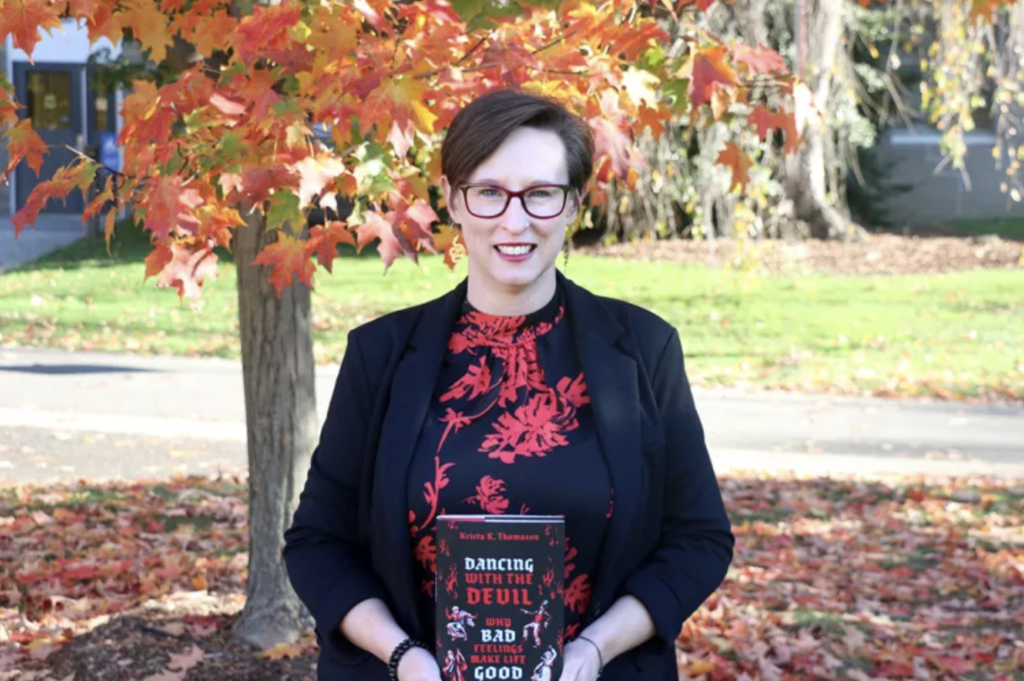Thought group: How to deal with our jealousy and anger? In order to stay good, should we suppress them, and not recognize them, but act in the direction of changing them, or basically recognize them, consider their existence necessary and necessary? These are the questions Krista Thomason, professor of philosophy at Swaremore College, is trying to answer. The report below is a report from his book “Dancing with the Devil”. This report is on the site Faculty Published below is your opinion:
***
Anger, jealousy or the pleasure of humiliation are classified among the most notorious human traits; Weeds are weeds that eat the flowers of the garden of life and must be eradicated. But what will happen if we interpret these hidden feelings in the secret place of the heart not as weeds but as earthworms in the garden of life?
Krista Thomason, professor of philosophy at Swarthmore College, invites us to reconsider our negative emotions in her latest book “Dance with the Devil”. In the opening lines of his book, he rejects the harmfulness of all negative emotions, because he believes that we should consider negative emotions as natural reactions to situations. “Negative emotions are the earthworms of the garden, not the weeds,” writes Thomason. They live just a few centimeters below the surface of the soil, slippery and slippery. Earthworms disgust most people, many of us prefer to just enjoy looking at flowers and forget about earthworms. But this is wrong, worms are as integral part of the garden as flowers, their presence means that the soil of this garden will live and flourish. Wishing for the absence of worms means the loss of the richness of the garden. “To have a beautiful garden, you better learn to deal with these slimy and slippery inhabitants. My intention is to help you recognize your worms.”
According to Thomason, we often use horrible labels about negative emotions, but we do not use such words about positive emotions, even in their most intense form. “When we talk about good feelings,” he writes, “no one says, ‘Be careful: you might become a perpetually happy person.’ or “It’s okay to be happy sometimes: you just have to manage it.” But as soon as one of the negative emotions appears, we soon face a flood of these recommendations.”
But why are negative and positive emotions treated with such different approaches about hookah? Thomason calls such an approach a double standard and considers this approach to be a double roof as a result of exaggeration. Thomason invites us to reflect on our anger throughout life. How many times have we been angry? Haven’t we often experienced anger towards the most beloved people in our lives? Although sometimes this anger causes the end of the relationship, but in most cases, we have rebuilt our relationship after the anger and stayed with our loved ones. Thomason writes: “If anger is as terrible as its labels, every person should remain bitter, friendless and lonely for the rest of his life after one anger.”
According to him The problem is that when it comes to negative emotions, your extreme examples are taken. For example, they mention the destruction of “jealousy” from the character of Iago in Shakespeare’s play Othello. But would an ordinary person really plot such a plot and commit a murder out of jealousy for his colleague’s promotion? Thomason writes: “Certainly not! If Iago wasn’t the hero of Shakespeare’s play, he would probably visit a mikde that evening with one or two other people and say something bad about his colleague and that would be it. Of course, such an ending is not interesting for a play to last, but we must remember that ordinary people are not Shakespearean villains.
Giving up extreme examples and accepting the fact that a person has always coexisted with negative emotions like slippery earthworms in the garden is the first step to realism. Thomason believes that in this situation, we will see that positive emotions are not free from harm. People have committed murder because of love and excessive love, their judgment has been impaired because of love, and they have sacrificed justice for sympathy and love. He writes: “We see that a person immersed in happiness may become delusional or even immersed in the belief of toxic positivity. Where does this baseless faith in our positive feelings come from? My answer is the same as before: from the same double standard of emotions.

Krista Thomason, professor of philosophy at Swarthmore College
Repressing saints and educating saints
Thomason continues to talk about the most famous approaches and ideas of training and self-control, and then he presents a third way to his audience. Using philosophy, literature and psychology, he tries to challenge the traditional concept of mental health; It examines the approach of scholars such as Aristotle to Darwin and Gandhi about the education of emotions and removes labels from negative emotions.
The book focuses above all on two well-known cognitive mechanisms in dealing with negative emotions. Thomason the first He calls the approach “Controlled Emotion Saints”. The most obvious examples of this approach are promoted in the school of stoicism, and figures such as Mahatma Gandhi with his devout lifestyle or Spinoza are his leaders. In this intellectual approach, Thomason writes, the goal is a way of organizing life in such a way that Do not experience bad feelings at all. Then he examines the example of Mahatma Gandhi, relying on one of George Orwell’s famous essays, and challenges high and devout standards and fear of bad feelings at the expense of austerity and neglecting normal life, and writes: “According to Orwell, in the example of Mahatma Gandhi, it is better to be a good person than to be a saint. Humans are not failed saints, but the saints of failed humans.
Thomason approach Second calls “Cultivated Emotion Saints”, he believes that the clear examples of this intellectual system can be examined in the thoughts of Aristotle and Confucius. “This approach now has a lot of supporters,” Thomason writes, “in this approach there is less pessimism than negative emotion, but a preference for bringing out the ‘mean worms,'” Thomason writes. So even though they are not looking for its eradication, they want to transform it. “Emotional intelligence training” and “emotion management” training workshops have a hot market these days. In these intervention methods, tools to direct negative emotions towards positive emotions are recommended and strategies for self-direction are practiced. However, the Saints who cultivate emotions leave no room for anger or jealousy.
Thomason, but the approach itself the third recommends, although he does not name it. He emphasizes We need to control, nurture or experience negative emotions. Here he takes help from Friedrich Nietzsche and writes:We must not “tame” our emotions, but allow them to remain “wild”, just like snakes that can bite but do not want to bite.“
In the dialectical necessity of negative emotions
Thomason assigns a special place to racial and gender discriminatory situations in the importance of negative emotions. Thomason cites Julia Cooper’s notes in Voices from the South for clarification. After the abolition of the slavery law, when black women got off at the train station with their luggage, the station officials would deliberately lock their hands behind their backs or hide themselves, but when faced with a white woman, they quickly rushed to her aid. Cooper would be angry to be in this situation and Thomason also considers this anger necessary and justified. According to him, if this anger was suppressed, the door for blacks would still turn on the same heel.
In another part of the book Dance with the Devil, Thomason rejects leaving the investigation of emotions to psychoanalytic science and believes that emotions are not just a neurological issue. According to him, feelings should be examined in Aristotle’s way and through dialectics, and by the way, he went to psychology to understand negative feelings. Thomason’s dialectic means investigating an issue through questioning and dialogue and gathering popular beliefs and common ideas about it.
Thomason seeks to investigate the dialectic of anger. He asks if anger means “desire to retaliate for pain”? So, philosophy gives us this opportunity to see through questions and dialogue what exactly is meant by “desire” and what does “pain” mean in this definition and Does an angry person always reciprocate pain? Can we find other ways to define anger? This method may seem abstract at first, but we will soon see that we have used the same dialectical method many times in everyday situations. If we are angry about an incident at work and we are worried about how we will react, we are actually doing an emotional dialectic before writing a letter of resignation or expressing our reaction to a colleague or talking about it.
Based on this argument, bad feelings should be considered a very natural aspect of self-care and a person’s attention to his place in the world. In response to being ignored, placed in an unfair position, or left behind, negative emotions emerge. Because anger or envy is a response to injustice and it is natural to experience negative feelings if we are left behind in social life.
According to Thomason, bad emotions are telling us painful truths about the world around us, and if we uproot or ignore them, there will be worse consequences. He writes:The pressure we feel today to suppress or control our emotions stems from a ruthlessly positivist ideology that says the good life is always happy and full of positive emotions and nothing else.“ This approach leads a person to self-censorship and does not allow him to react to injustice, because it brings the origin of everything back to the person himself and requires him to be a happy and positive member of his society, no matter what pressure he endures.
Thomason believes that negative emotions play an essential role in self-enrichment and self-care. But focusing on the unpleasant qualities of negative emotions causes us to ignore their value. Negative emotions help us focus on ourselves when we’ve been hurt or humiliated. “If someone ever disrespects us,” he writes, “getting angry at the disrespect is a way to activate a respectful relationship, a warning to the other that we are worthy of respect.” This argument is even true of the pleasure derived from watching the humiliation of another. The feeling of happiness from another’s suffering usually comes to us about people who consider themselves superior to us in various situations. So if they fail, we’ll feel a little better. For example, imagine that in the group of neighborhood mothers, there is a self-righteous mother who considers herself higher and better than the rest, when her homemade cake remains untouched and none of the guests touch it, we cannot stop smiling with satisfaction. Maybe because our sense of self-worth increases a little against his arrogance. In addition, you should not panic and be afraid of such feelings. Because just as positive emotions are transitory, negative emotions can subside with the same speed in normal people.
A dance between two arms
Thomason uses metaphors such as “saints” and “the devil” in his book, but “Dance with the Devil” does not focus on religious teachings. In the framework of this work, Thomason presents a critique of the ethics of selfishness and defends worldly life. Many religious teachers categorize overcoming self and suppressing emotions as high human values, but Thomason defends a view in which the development of emotions and a non-holy self is recommended despite vulnerability and suffering.
“We must first give up the pretense of being an emotional saint,” he writes, “not because it’s impossible, just because it’s not worth wanting.” We have to admit that not being a saint anymore is not that we wallow in the worst parts of human emotions. Emotional saints consider the manifestation of emotions to belittle human life, but natural life is a collection of angers and loves, compassions and jealousies, because a meaningful life is full of emotions. By questioning and examining emotions and triggers, we can begin to analyze the complexities of our emotional lives and understand who we are. When we don’t suppress part of our emotions, it means we have reached a balance. Acknowledging the darker parts of our emotional landscape while still striving for growth and happiness is a reality of life. This is a dance between two arms: On the one hand, negative emotions and that wild nature that can but does not bite, and the other side is our superior and cultivated self.. Recognizing these two is essential for a meaningful life and being a complete human being.”
Krista Thomason is a professor of philosophy at Swarthmore College. This is a brief report from the following source:
Thomason, Krista K. Dancing with the Devil: Why Bad Feelings Make Life Good. Oxford University Press, 2024.
216216
منبع: www.khabaronline.ir




